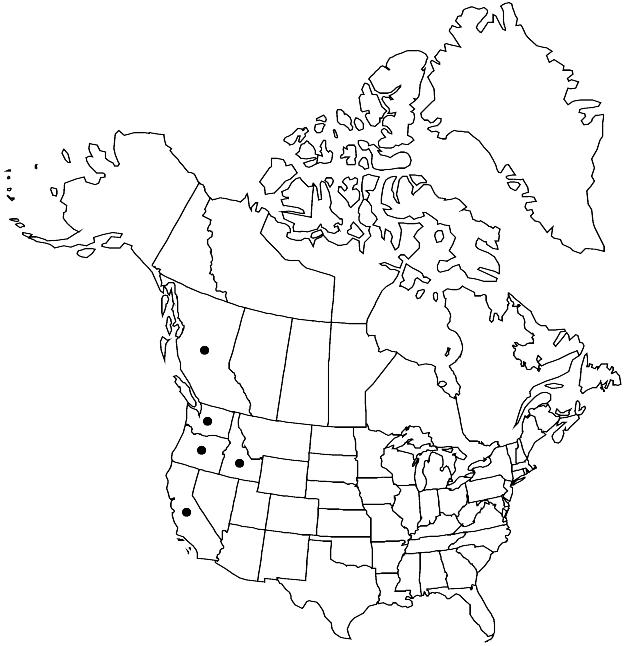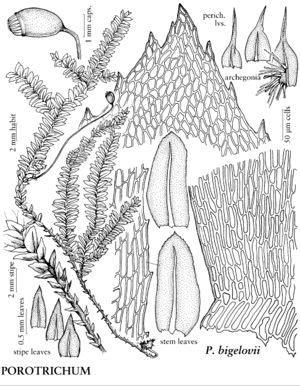Difference between revisions of "Porotrichum bigelovii"
Canad. Rec. Sci. 6: 18. 1894.
FNA>Volume Importer |
imported>Volume Importer |
||
| (5 intermediate revisions by 2 users not shown) | |||
| Line 12: | Line 12: | ||
}}{{Treatment/ID/Special_status | }}{{Treatment/ID/Special_status | ||
|code=F | |code=F | ||
| − | |label= | + | |label=Illustrated |
}} | }} | ||
| − | |basionyms={{Treatment/ID/ | + | |basionyms={{Treatment/ID/Basionym |
|name=Hypnum bigelovii | |name=Hypnum bigelovii | ||
|authority=Sullivant | |authority=Sullivant | ||
| + | |rank=species | ||
| + | |publication_title=in War Department [U.S.], Pacif. Railr. Rep. | ||
| + | |publication_place=4(2, pap. 5): 189, plate 8. 1857 | ||
}} | }} | ||
|synonyms={{Treatment/ID/Synonym | |synonyms={{Treatment/ID/Synonym | ||
|name=Thamnobryum bigelovii | |name=Thamnobryum bigelovii | ||
|authority=(Sullivant) Nieuwland | |authority=(Sullivant) Nieuwland | ||
| + | |rank=species | ||
}} | }} | ||
|hierarchy=Neckeraceae;Porotrichum;Porotrichum bigelovii | |hierarchy=Neckeraceae;Porotrichum;Porotrichum bigelovii | ||
| Line 45: | Line 49: | ||
-->{{#Taxon: | -->{{#Taxon: | ||
name=Porotrichum bigelovii | name=Porotrichum bigelovii | ||
| − | |||
|authority=(Sullivant) Kindberg | |authority=(Sullivant) Kindberg | ||
|rank=species | |rank=species | ||
| Line 59: | Line 62: | ||
|publication title=Canad. Rec. Sci. | |publication title=Canad. Rec. Sci. | ||
|publication year=1894 | |publication year=1894 | ||
| − | |special status=Endemic; | + | |special status=Endemic;Illustrated |
| − | |source xml=https:// | + | |source xml=https://bitbucket.org/aafc-mbb/fna-data-curation/src/2e0870ddd59836b60bcf96646a41e87ea5a5943a/coarse_grained_fna_xml/V28/V28_964.xml |
|genus=Porotrichum | |genus=Porotrichum | ||
|species=Porotrichum bigelovii | |species=Porotrichum bigelovii | ||
Latest revision as of 21:39, 5 November 2020
Plants 2–5 cm. Primary stems complanate-foliate. Primary stem leaves erect-spreading, deltoid, 1–2 mm; margins plane, entire to slightly serrulate; apex acute; costa double, short, or single; basal laminal cells elongate-rhomboidal, 4–10 × 1 µm, smooth; apical cells elongate-rhomboidal, 5–8 µm. Secondary stem leaves 2.5–3 mm; basal laminal cells 8 × 1 µm; medial cells 5–10 × 1 µm; apical cells rhombic to rhomboidal, 3–5 × 2–3 µm. Branch leaves erect to erect-spreading, 1.5 mm; costa to 3/4 leaf length; basal laminal cells 7–10 × 2–3 µm; medial cells 3–7 × 2 µm; apical cells rhombic 3–4 × 2 µm. Perichaetial inner leaves with margins serrate distally, ecostate or costate, distal medial laminal cells fusiform to linear. Seta reddish brown. Capsule erect to horizontal; exostome teeth from broad base tapering toward apex; endostome cilia present.
Phenology: Capsules mature Mar–Aug.
Habitat: Soil, rock, logs, under shaded cliffs or shaded boulders by streams, wet rock crevices in forests
Elevation: low to moderate elevations (0-600 m)
Distribution

B.C., Calif., Idaho, Oreg., Wash.
Discussion
In the flora area, Porotrichum bigelovii is immediately distinguished from other dendroid mosses by its soft appearance due to the complanate leaves and stem. In addition, the costa narrowing toward the apex separates P. bigelovii from species of Thamnobryum.
Selected References
None.
